Content of the article
- /01 What are SMART goals?
- /02 Benefits of using SMART goals in marketing
- /03 How to formulate SMART goals: step-by-step instructions
- /04 Examples of successful SMART goals in marketing
- /05 Common mistakes when setting SMART goals
- /06 How to track progress and adjust goals
- /07 Advanced approaches to SMART goals

SMART goals play a key role in transforming ideas into real results. The methodology based on five steps – Specific, Measurable, Achievable, Relevant, Time-bound – allows you to clearly define tasks, avoid vague wording, and optimize resource costs. Using the SMART approach helps to increase the transparency of the process, team responsibility, and allows for timely tactical adjustments, which is especially important in the face of rapid market changes.
In this article, we’ll look at what SMART goals are, why they are so important for marketing, and how to apply the methodology step by step. How to set goals that reinforce the strategy, track progress in time, and adjust them. This guide will be useful for business owners, marketers, and anyone who wants to measure the results of their campaigns today.
What are SMART goals?
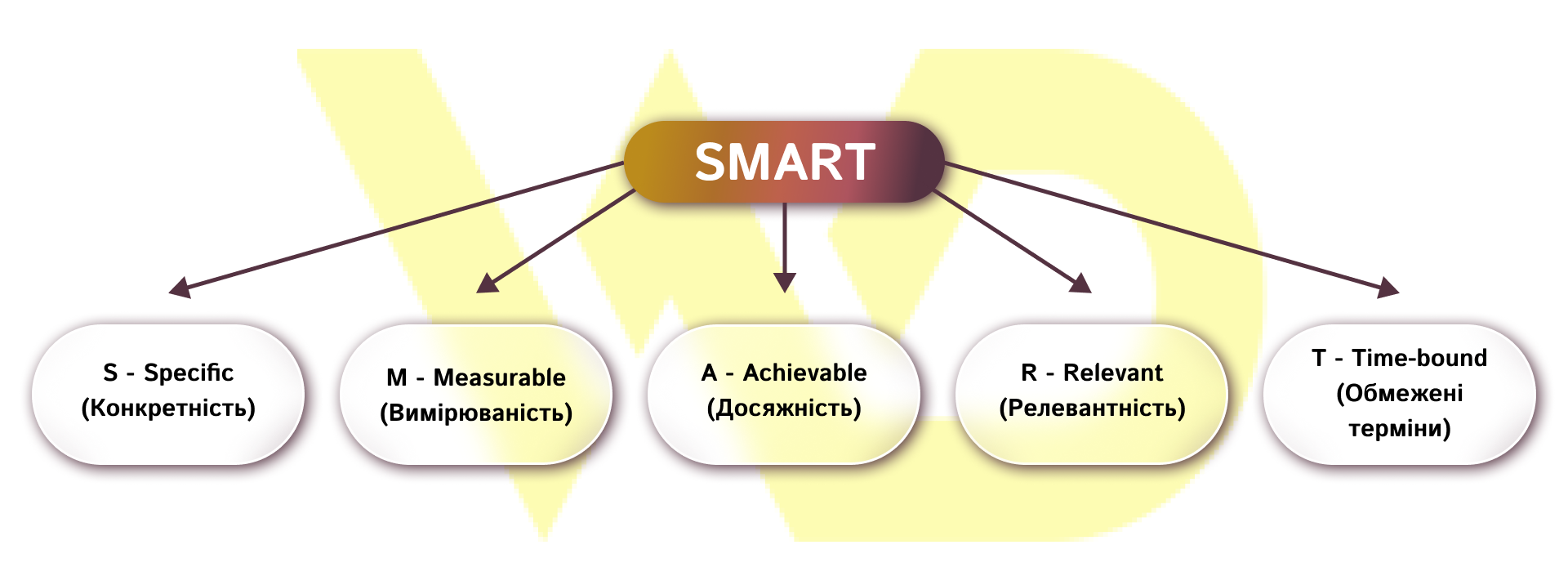
The SMART methodology consists in formulating marketing objectives according to 5 clear criteria. This creates a solid foundation for planning and evaluating the effectiveness of any campaign.
- S – Specific.
The goal formulation should contain precise parameters: the desired result, those responsible for its implementation, the channels of engagement, and the reason for the need to achieve this particular indicator.
- M – Measurable.
Each goal has a clear quantitative or percentage limit that can be used to objectively verify achievement. Metrics can include the number of leads, average cost per conversion, bounce rate, or time on site.
- A – Achievable.
A realistic assessment of budgetary, time and human resources ensures that the goal is not beyond the company’s capabilities. At this stage, previous indicators are analyzed, cases of similar projects are compared, and the scope of work required to achieve the goal is clarified.
- R – Relevant.
Each goal should be in line with the overall business strategy and focus on the company’s key priorities.
- T – Time-bound.
Setting a clear project completion date and intermediate deadlines promotes discipline and prevents tasks from «floating» in time. A detailed breakdown into stages with deadlines helps to control the process and make timely adjustments.
The combination of all five components into a single SMART goal ensures high quality planning, allows you to clearly see progress and make informed decisions at each stage of implementation.
Once the components of the SMART methodology are defined and it is clear how to build clear, measurable, and realistic goals, it is worth considering what specific benefits their application brings to marketing practice.
Benefits of using SMART goals in marketing
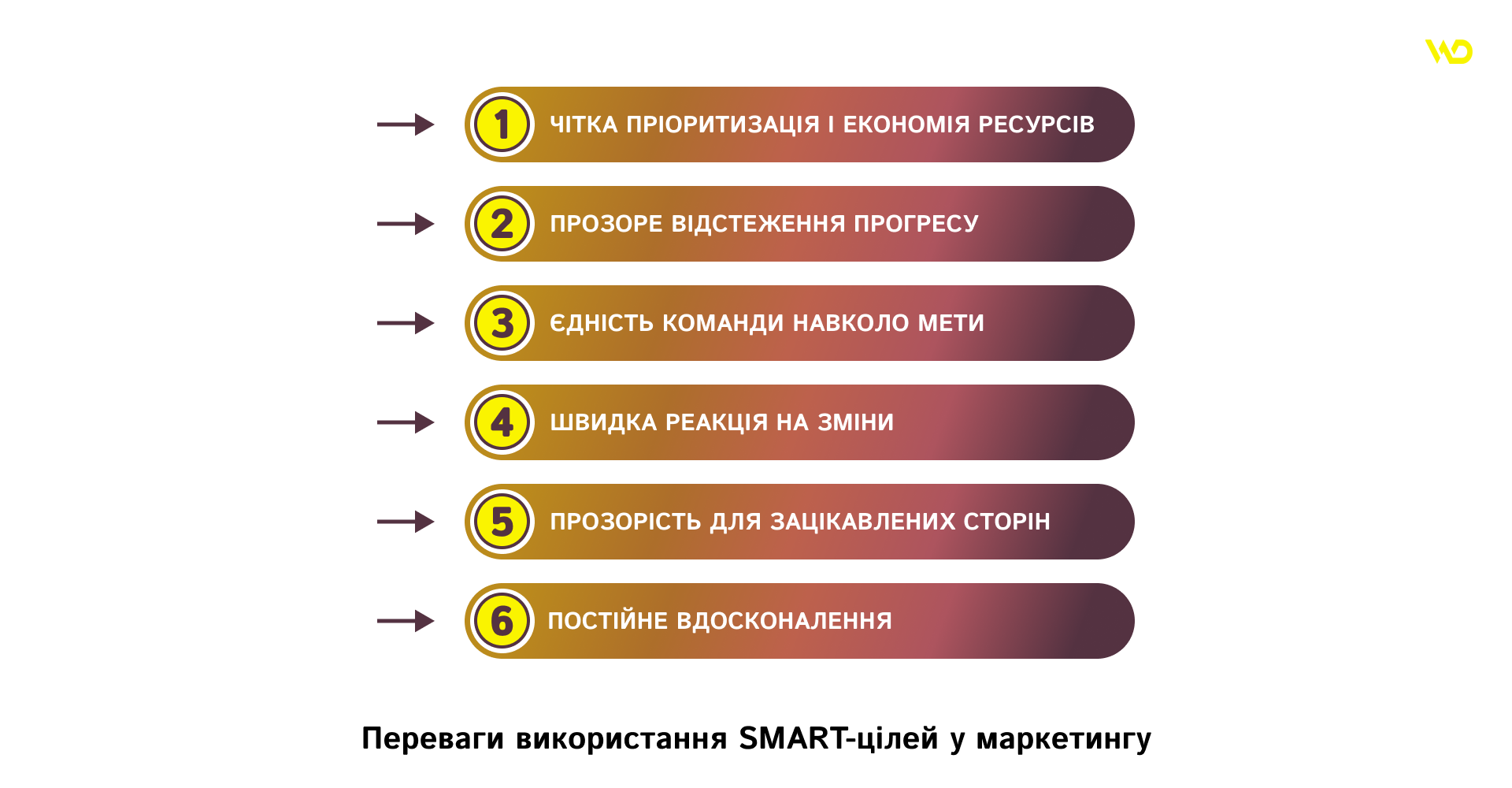
When every decision has to be balanced and timely, the SMART approach helps to change the situation for the better. Using SMART goals helps to create a clear architecture for planning marketing tasks, so that each stage of work is reflected in specific indicators and deadlines. The combination of specificity and measurability allows you to track progress in real time and make prompt adjustments if necessary. At the same time, clearly defined Time-bound deadlines ensure discipline and prevent projects from stretching out over time.
Each team member receives clear responsibility for their own segment of work, which increases team cohesion and motivation. Thanks to a transparent KPI system, results are easy to demonstrate to management and investors, which builds trust in marketing initiatives. Finally, the integration of SMART goals into the plan-act-check-adjust cycle facilitates the accumulation of experience and the continuous improvement of tactics, as lessons from past campaigns become the basis for new, more effective goals.
Now that the benefits of the SMART approach are clear, it’s time to take a closer look at how to set goals using this methodology to make them work in practice.
How to formulate SMART goals: step-by-step instructions
To make the SMART method work, you should follow a clear sequence of actions. The following instructions will help you build a process from an idea to a documented goal.
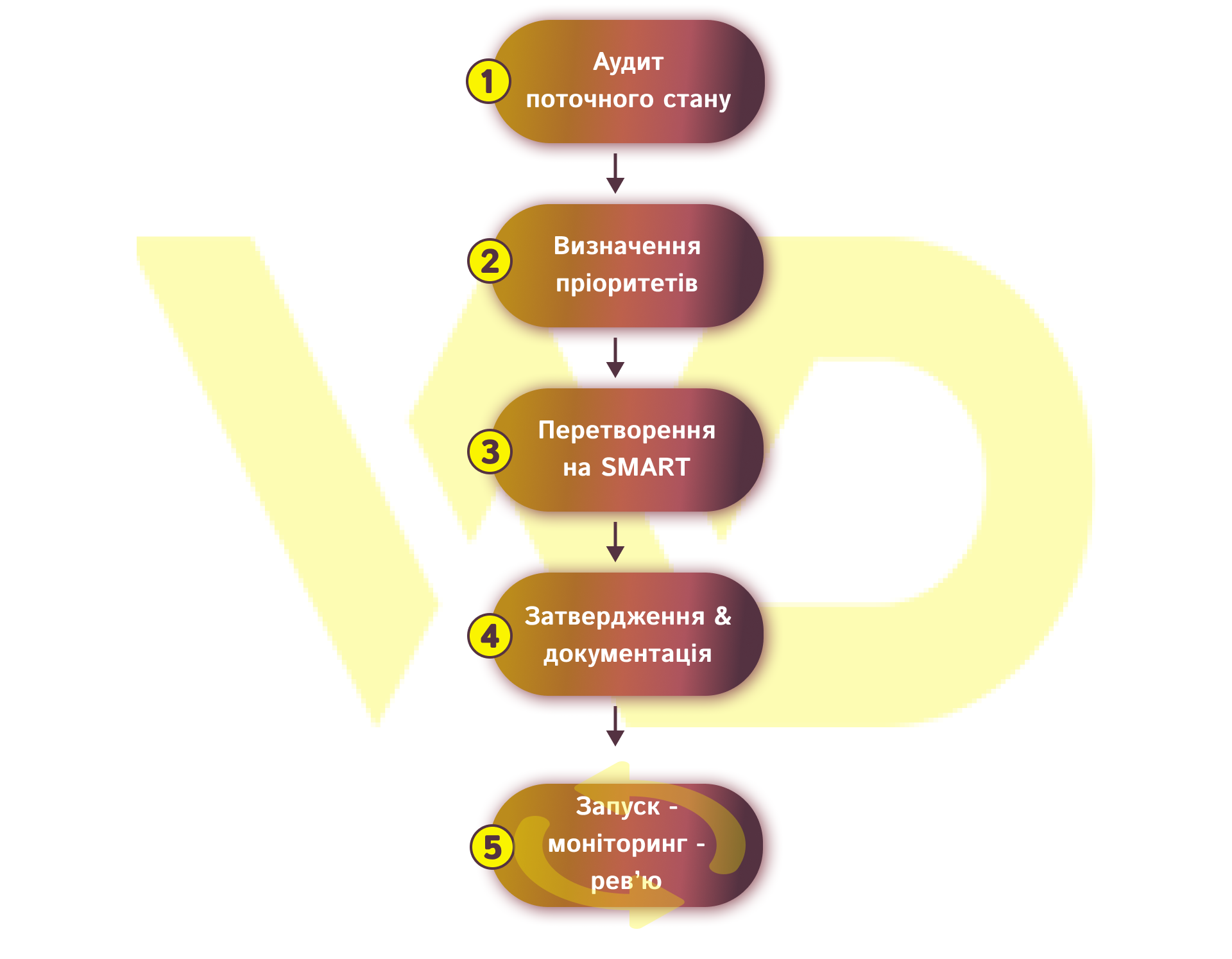
- Audit the current state.
Before setting a new goal, you need to understand where it starts. Analyze current indicators (traffic, conversions, average lead price, etc.), the results of previous campaigns, and available resources (budget, team, tools). For example, a blog receives 4,000 visits per month, of which 5% convert to subscribers.
Want to understand where to start to get results?
Order a website or advertising account audit from WEDEX. Our experts will analyze the data and help you establish a clear starting point for your strategy.
- Prioritization and general focus.
A business request is formulated: what is the priority – increasing coverage, increasing loyalty, or optimizing costs.
- Transforming the task into a SMART structure.
Based on the analysis and priority, the goal is detailed in accordance with the five SMART criteria.
- (S) Specificity: write down what actions will be performed («create a lead magnet and set up a subscription form»);
- (M) Measurable: choose clear metrics and set up reports («grow the database from 4,000 to 5,000 contacts»);
- (A) realistic: check the budget and timeline («$200/month for social media advertising»);
- (R) alignment with the strategy: coordinate with management to ensure that the goal supports the broader business plans;
- (T) timing: set an end date and intermediate checkpoints.
Example: «Increase the email subscriber base from 4,000 to 5,000 by the end of August by creating an e-book and launching targeted advertising with a budget of $600».
- Approval and documentation.
Once the goal is agreed upon, a short document or entry is made in the corporate project management system. It should include:
- responsible persons
- resources and budget;
- interim deadlines.
This prevents the goal from being lost among hundreds of other tasks.
- Launch, monitor and review.
Once the goal is launched, it is important to maintain regular monitoring. Every week, you should update short reports in a convenient work environment, such as Slack or Trello. Once a month, a detailed analysis of intermediate results is carried out. If there is a deviation from the plan of more than 10%, it is advisable to quickly test other approaches – change the creative, advertising channel, or the offer itself.
Example: the first weeks revealed that leads were coming from Facebook at a lower cost, so part of the budget was reallocated to optimize CPL.
Following this sequence ensures that each SMART goal follows a predictable, transparent, and manageable path from the initial idea to the final report.
Examples of successful SMART goals in marketing
To see how the SMART methodology works in practice, let’s look at four cases from different areas.
Increase website traffic by 20% in 3 months (SEO)
A tech company had a task to increase organic traffic to its corporate blog in order to increase the number of leads without additional costs for paid sources. After analyzing the traffic and identifying key pages, SEO specialists created a SMART plan:
- Specific: publishing two SEO-optimized posts per week and updating the five most popular old articles;
- Measurable: increase monthly visits from 5,000 to 6,000;
- Achievable: use of Ahrefs and SEMrush tools for keyword research and in-house copywriters for rapid content creation;
- Relevant: organic traffic directly correlates with the number of leads and sales in the B2B segment;
- Time-bound: the entire set of measures was implemented by the end of the quarter.
Three months later, the results exceeded expectations: instead of +20%, the blog received +25% of organic traffic, which helped reduce the cost per lead by 15%.
Get 500 Instagram followers in 30 days
The cosmetics brand noticed that the 18–35-year-old niche was highly competitive, but the lack of clear communication on social media was holding back the growth of subscribers. The team set a SMART goal:
- Specific: to launch three collaborations with micro bloggers and targeted advertising to the Look-a-Like audience;
- Measurable: to get at least 500 new subscribers;
- Achievable: based on the average CPL of $1.50 per subscriber, the budget is $750;
- Relevant: increasing awareness among the target audience leads to greater loyalty and sales through the Instagram store;
- Time-bound: the campaign lasted 30 days.
As a result, the number of subscribers grew by 520, and the engagement rate increased by 12%.
Reduce CPL in Google Ads by 25% in 4 months
A small IT startup was interested in optimizing its advertising costs because the average cost per lead of $40 made it difficult to scale. Using a SMART approach, they planned the following:
- Specific: test five new creative variants and three audiences;
- Measurable: reduce CPL from $40 to $30;
- Achievable: to launch new ads based on the data from the 2024 campaigns, which had already shown the viability of certain creatives;
- Relevant: reducing the cost of a lead increases the overall ROI of an advertising campaign;
- Time-bound: all tests and optimization should be completed by the end of the next quarter.
Four months later, CPL reached $28, and the overall conversion rate increased by 5%.
Improve mobile traffic conversion from 2.3% to 5% by the end of the quarter
One of the e-commerce platforms noticed that most visitors came from mobile devices, but the conversion rate was much lower than on the desktop. To solve this problem, they set SMART goals:
- Specific: to conduct a UX/UI audit of the mobile version, speed up page loading, and simplify checkout to one step;
- Measurable: to increase conversion from 2.3% to 5%;
- Achievable: thanks to Hotjar and Google Analytics tools, we identified problem areas that were easy to fix;
- Relevant: more than 60% of traffic comes from mobile devices, so their conversion is crucial for turnover;
- Time-bound: all changes were implemented by the end of the reporting quarter.
As a result, the mobile conversion rate reached 5.2%, which resulted in +18% of additional revenue from mobile users
Each of these examples shows how detailed SMART goal setting allows you to plan, track, and optimize marketing activities to maximize the effect.
Common mistakes when setting SMART goals
In the process of implementing the SMART methodology, there are five common pitfalls that can hinder promotion even if you have experienced professionals. Let’s take a closer look at them and find out how to avoid such mistakes.
Vague wording
The most common mistake is to use abstract phrases instead of clear tasks. When the strategy says «improve marketing», the team can interpret it in different ways: some will work on creativity, others on budget, and still others on promotion channels. As a result, none of these areas receives enough attention. To avoid scattering, you should immediately specify what exactly is being improved, for example, increasing the click-through rate of banners by 10% or increasing the open rate of email newsletters by 25%.
Lack of measurability
Another critical mistake is setting goals without specific metrics. Without metrics, it’s impossible to understand whether the campaign is moving in the right direction. For example, the phrase «increase sales» does not give an idea of how much the volume of orders should increase. In such a situation, an additional 100 sales can be perceived as a success or a failure, depending on your expectations. That’s why it’s worth setting quantitative limits, such as «15% increase in sales compared to the previous month».
Ignoring resource constraints
Often, marketers get carried away with ambitious ideas without checking whether they have sufficient resources. A promise to «get 1,000 leads in a week» without taking into account budget, human resources, or technical capabilities can turn into a waste of time and money. It’s important to conduct a quick resource audit before setting a goal: assess the available advertising budget, availability of specialists, and complexity of technical integration to make the goal realistic.
Inconsistency with the overall strategy
If the goal does not fit into the company’s long-term plan, all efforts can be wasted. For example, launching a large-scale TikTok campaign will not make sense for a B2B company with a narrow corporate audience, even if it impresses with high reach. Each SMART goal should be a logical step in the sequence of business initiatives – from product improvement to entering new markets.
Lack of clear deadlines
Finally, the lack of a time frame robs the goal of momentum. When there is no defined completion date, tasks are often «up in the air» and can be postponed. The absence of deadlines also reduces motivation: the team does not feel urgent and works more slowly. Therefore, it is necessary to immediately set deadlines and intermediate checkpoints to maintain momentum and discipline.
Avoiding these mistakes will help make the process of setting SMART goals truly effective and increase the likelihood of achieving the desired results without unnecessary delays and misunderstandings.
How to track progress and adjust goals
Once SMART goals have been launched, the key step is to monitor their implementation and make timely changes. To make the process effective, you should follow four practical steps.
- Automate data collection.
Setting up a unified information collection system provides transparency and saves time. You should use:
- Google Analytics to monitor web traffic and user behavior;
- CRM system (for example, HubSpot or Bitrix24) to track leads and interact with them;
- BI dashboard (Power BI, Data Studio) for building summary charts and operational analysis of indicators in a single window.
Instead of manually exporting reports, all key metrics are updated automatically, allowing you to see the latest figures in real time.
- Regular reports and reviews.
Weekly and monthly check-ins help you stay on top of your project. Weekly updates in Slack, Trello, or another tool allow the team to briefly share what changes have occurred and whether there are deviations from the planned indicators. And monthly reviews include detailed presentations of the results to management or stakeholders, where not only numbers are analyzed, but also qualitative insights (for example, changes in audience behavior or the effectiveness of individual channels).
- Application of the PDCA cycle.
The Plan-Do-Check-Act method will become the basis for continuous improvement.
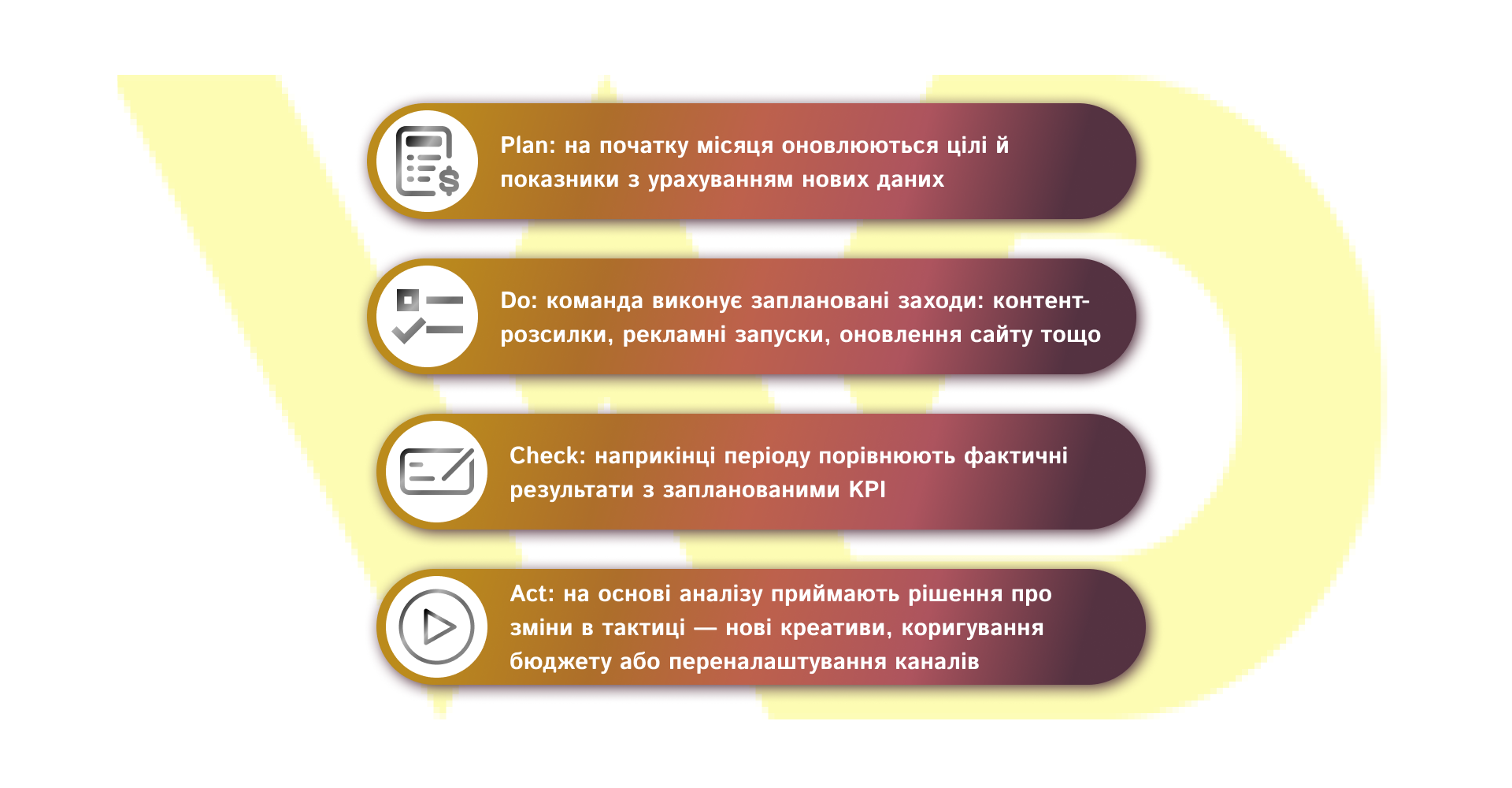
- Identification of risk triggers.
Instead of waiting for the end of the reporting period, «alarms» are implemented: if the deviation from the key metric exceeds 10%, the system automatically sends notifications to those responsible. For example, when the average cost per lead grows by 12% above the planned value, a mini-A/B test of a new creative is launched; if the click-through rate of an email campaign drops by 15%, the subject line and content are revised.
This approach allows you to respond quickly to market changes and adjust your strategy «here and now», not just based on the results of quarterly reports.
Advanced approaches to SMART goals
Sometimes the basic five-component SMART structure is not sufficient to meet the needs of a rapidly changing market or complex strategies. There are three more «advanced» variations that can help make goal setting even more flexible and effective.
Flexible SMART goals for sprints and rapid tests
In the classic approach, the deadline is often the end of the quarter, but in the context of intensive A/B testing or short advertising campaigns, this is too much time. Flexible SMART goals break down a large deadline into mini-sprints: instead of «increase traffic to by 20% in a quarter», we set «test three variants of headlines in the landing page within 7 days and choose the best one».
This approach has two key advantages. First, the result is visible faster – within a week, it becomes clear which headline generates the most clicks. Secondly, the team does not focus solely on the long-term goal, but regularly receives short feedback cycles.
Tip: set a sprint period (7-14 days) and clear criteria for «superiority» in the SMART goal (for example, +10% CTR compared to the current figure).
SMART goals for multichannel campaigns
When email campaigns, targeting, and SEO work simultaneously, it’s important not to lose synergy. Define one overall SMART goal and then distribute subgoals across channels.
- Email: +10% through a series of drip campaigns with personalized lead magnets;
- SMM: +12% through weekly live broadcasts and a UGC contest;
- PPC: +8% due to audience optimization and new creative.
All these sub-goals should be aligned with a single budget and common KPIs. Such a plan ensures that even if one of the channels fails, the others will compensate for the gap, and the overall goal will be achieved.
Real case: a large Ukrainian FMCG company synchronized email marketing and Facebook campaigns, which allowed it to keep CPL at $5 with an overall increase in leads by 35% in two months.
Integrating SMART with the OKR system
SMART goals work well at the level of projects and tactical tasks, while OKRs (Objectives and Key Results) work well at the level of strategy and global ambitions. The combination of the two methods allows you to clearly link specific actions to larger business goals.
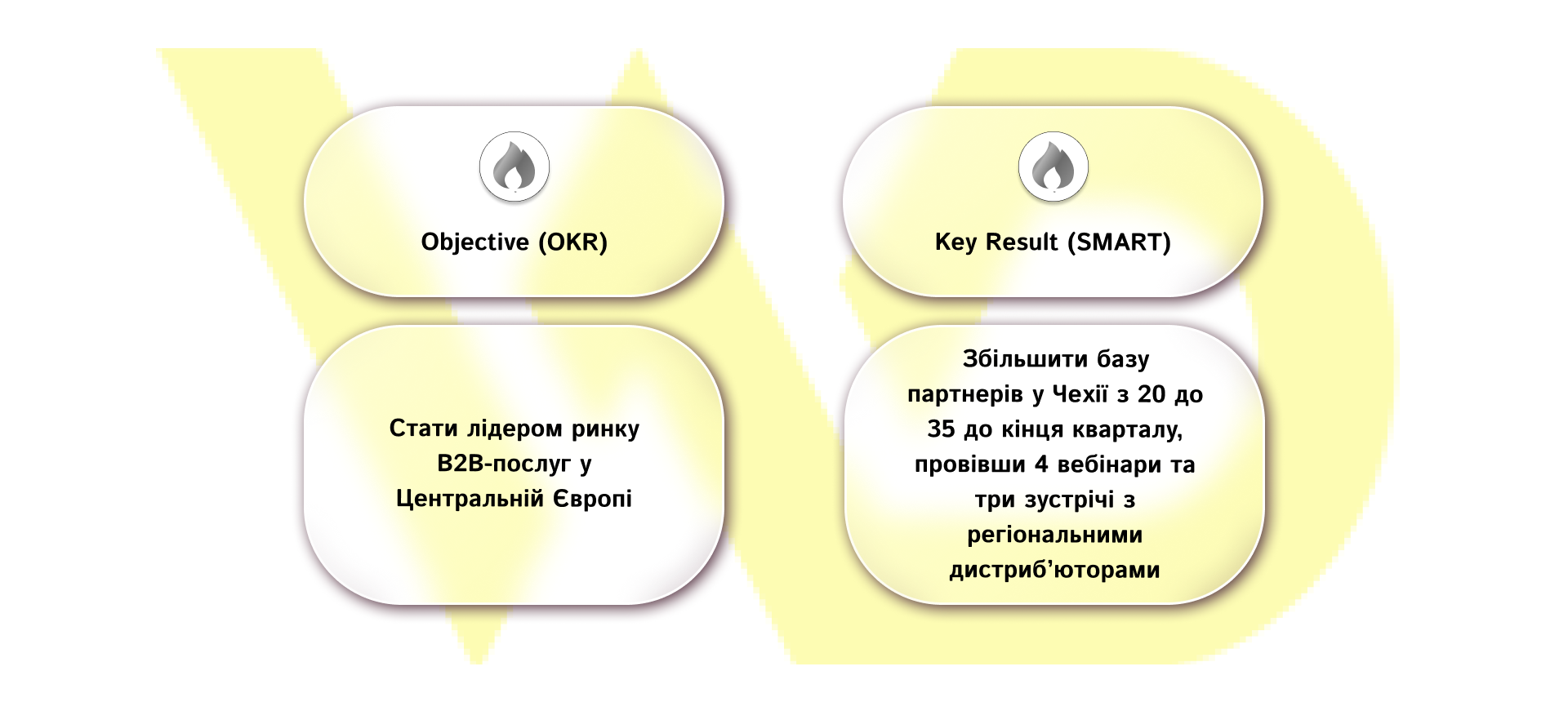
In this case, each Key Result is formulated in detail according to SMART criteria and serves as a support for the promotion of the overall strategy. Thanks to this connection, the team sees how weekly actions (drip campaigns, calls, online meetings) lead to a bigger goal – capturing a new market.
The key to success is to maintain a two-way communication between OKRs and SMART goals – to update Key Results in light of changes in Objectives and vice versa.
By adding these extended approaches, you can flexibly adapt the SMART methodology to any task and ensure maximum return on each goal.






 19/09/2025
19/09/2025  1338
1338


